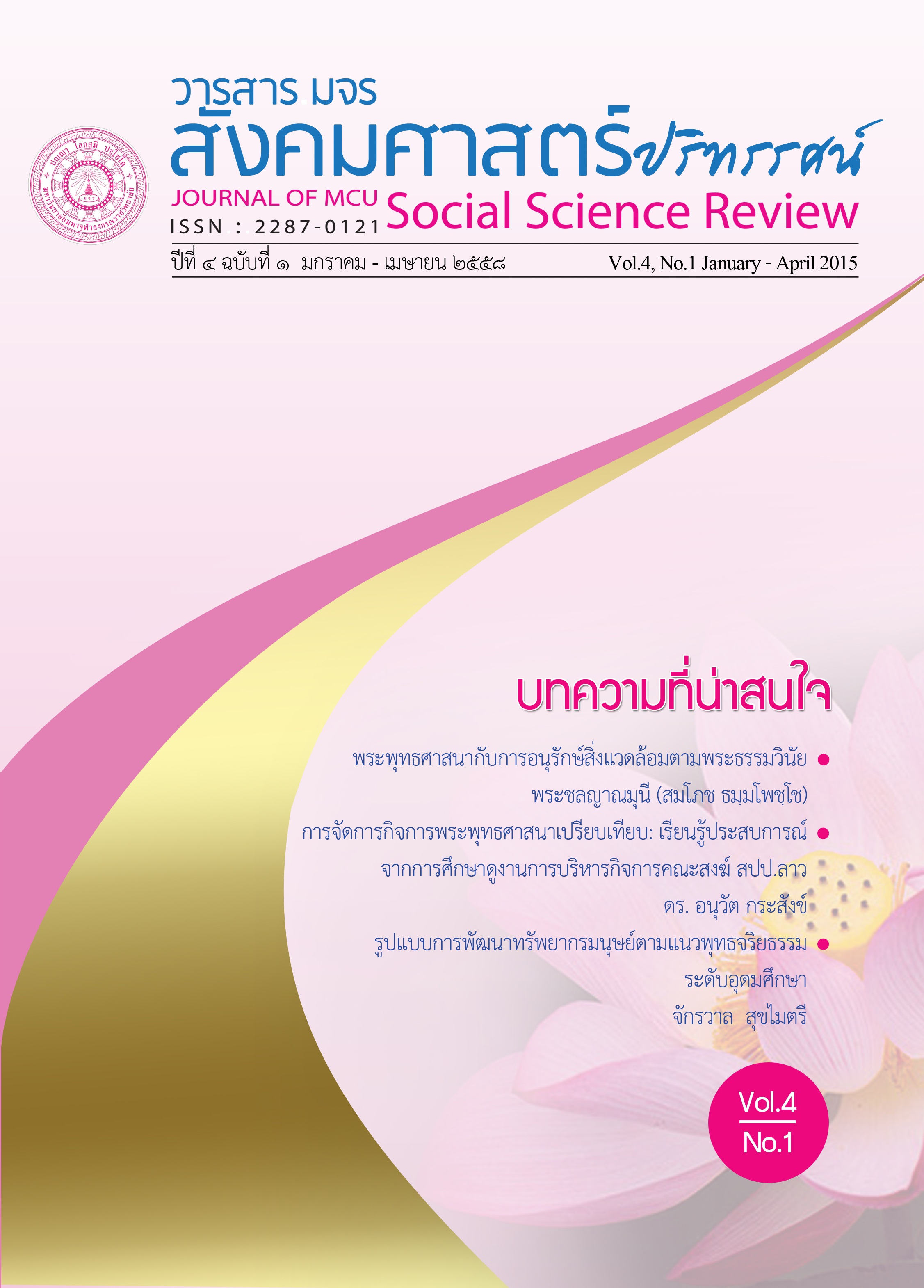การพัฒนาสมรรถนะบุคลากรทางการศึกษาตามแนวไตรสิกขา
คำสำคัญ:
การพัฒนาสมรรถนะ, บุคลากรทางการศึกษา, ไตรสิกขาบทคัดย่อ
บทความนี้มีวัตถุประสงค์เพื่อนําเสนอแนวทางในการพัฒนาสมรรถนะของบุคลากรทาง การศึกษา โดยนําหลักพุทธธรรมมาบูรณาการกับการพัฒนา ตามหลักสมรรถนะหลัก ๕ ด้านคือ การมุ่งผลสัมฤทธิ์ การบริการที่ดี การสั่งสมความเชี่ยวชาญในงานอาชีพ จริยธรรม ความร่วมแรง ร่วมใจ และตามหลักไตรสิกขาคือ ศีล สมาธิ ปัญญา การพัฒนาสมรรถนะบุคลากรเป็นกระบวนการ เพิ่มพูนความสามารถในการปฏิบัติงานของบุคลากรทั้งในด้านความคิดเห็นที่มีต่องานและผลของ การปฏิบัติงานของบุคลากรให้ดียิ่งขึ้นกว่าเดิมโดยพัฒนาในแต่ละด้านขององค์ประกอบของ สมรรถนะการพัฒนาแบ่งเป็น ๒ ลักษณะใหญ่ๆ คือ ส่งเสริมคุณวุฒิ ด้วยการส่งไปศึกษาต่อ และการ เสริมสมรรถภาพด้วยการจัดฝึกอบรม การศึกษาดูงาน ซึ่งมีทั้งแนวคิดการจัดการฝึกอบรมอย่างเป็น ระบบ แนวคิดการพัฒนาบุคคลและฝึกอบรม ทั้งนี้การพัฒนาบุคคลจะครอบคลุม ๓ เรื่อง คือการ ฝึกอบรม การศึกษา และการพัฒนา การพัฒนาคนให้เป็นคนดีมีความสุข และเป็นทรัพยากรมนุษย์ที่ มีคุณภาพ การพัฒนานั้นก็คือการศึกษา ในทางพุทธศาสนาก็คือ ไตรสิกขา ซึ่งเป็นการฝึกอบรมหรือ พัฒนาตน อันประกอบด้วย ศีลสิกขา จิตตสิกขา และปัญญาสิกขา หรือเป็นการปฏิบัติฝึกหัดอบรม ตนด้วยหลักศีล สมาธิ ปัญญานั้นเอง
เอกสารอ้างอิง
(๑) หนังสือ
กรมวิชาการ. คู่มือการสร้างค่านิยม คุณธรรม จริยธรรม และวินัย. กรุงเทพมหานคร: โรงพิมพ์คุรุสภาลาดพร้าว. ๒๕๔๑.
ชูชัย สมิทธิไกร. การฝึกอบรมบุคลากรในองค์การ. กรุงเทพมหานคร: สํานักพิมพ์แห่งจุฬาลงกรณ์มหาวิทยาลัย, ๒๕๕๐.
ฐีระ ประวาลพฤกษ์, การพัฒนาบุคลากรและการฝึกอบรม. ตําราเอกสารวิชาการ ฉบับที่ 4. กรุงเทพมหานคร: หน่วยศึกษานิเทศก์สํานักงานสภาสถาบันราชภัฏ, ๒๕๓๘.
ธารพรรษ สัตยารักษ์ หลักการและมุมมองจากมืออาชีพ. กรุงเทพมหานคร: โอ.เอส.พริ้นติ้งเฮ้าส์, ๒๕๕๘.
พระธรรมปิฎก (ป.อ. ปยุตโต), การพัฒนาที่ยั่งยืน. กรุงเทพมหานคร: สํานักพิมพ์มูลนิธิพุทธธรรม, ๒๕๓๙.
เพระพุทธศาสนาพัฒนาคนและสังคม. กรุงเทพมหานคร: โรงพิมพ์การศาสนา, ๒๕๔๒.
สํานักงานคณะกรรมการการศึกษาแห่งชาติ, เอกสารวิชาการการประเมินผลการจัดการศึกษา กรุงเทพมหานคร: สํานักประเมินผลการจัดการศึกษา, ๒๕๔๖.
สุภาพร พิศาลบุตรและยงยุทธ เกษสาคร. การพัฒนาบุคคลและการฝึกอบรม. พิมพ์ครั้งที่ ๕ กรุงเทพมหานคร: BK อินเตอร์พรินท์จํากัด, ๒๕๔๔. สุมน อมรวิวัฒน์, การสอนโดยสร้างศรัทธาและโยนิโสมนสิการ. พิมพ์ครั้งที่ ๒. กรุงเทพมหานคร: โรงพิมพ์โอเดียนสโตร์, ๒๕๓๐.
สุรพล สุยะพรหมและคณะ, พื้นฐานการจัดการ. กรุงเทพมหานคร: โรงพิมพ์มหาจุฬาลงกรณราชวิทยาลัย, ๒๕๕๕.
(๒) วารสาร
สมศรี เพชรโชติ, การนํากลยุทธ์ของการพัฒนาทรัพยากรมนุษย์มาใช้ในประเทศไทย, บทความในวารสารการพัฒนาทรัพยากรมนุษย์ มหาวิทยาลัยรามคําแหง ปีที่ 9 ฉบับที่ ๑ ตุลาคม ธันวาคม ๒๕๕๘.
(๓) วิทยานิพนธ์
คนึงนิจ อนุโรจน์, ปัจจัยที่มีอิทธิพลต่อสมรรถนะของนักพัฒนาทรัพยากรมนุษย์กองทัพอากาศ. ดุษฎีนิพนธ์ปรัชญาดุษฎีบัณฑิต, บัณฑิตวิทยาลัย มหาวิทยาลัยรามคําแหง. ๒๕๕๑.
๒. ภาษาอังกฤษ
(1) Book
McFarland, Management: Foundation & Practices, 5thed, New York : Macmillan Publishing Inc, 1979.
McGowrty and Meuse. The Team Developer. New York: Branford and Bigelow, 2001.
Peter Drucker. What Makes an Effective Executive. Harvard Business Review, 2004.
Reddin, William J. Managerial Effectiveness. New York: McGraw-Hill, 1970.
ดาวน์โหลด
เผยแพร่แล้ว
รูปแบบการอ้างอิง
ฉบับ
ประเภทบทความ
สัญญาอนุญาต
ลิขสิทธิ์ (c) 2018 วารสาร มจร สังคมศาสตร์ปริทรรศน์

อนุญาตภายใต้เงื่อนไข Creative Commons Attribution-NonCommercial-NoDerivatives 4.0 International License.
เพื่อให้เป็นไปตามกฎหมายลิขสิทธิ์ ผู้นิพนธ์ทุกท่านต้องลงลายมือชื่อในแบบฟอร์มใบมอบลิขสิทธิ์บทความให้แก่วารสารฯ พร้อมกับบทความต้นฉบับที่ได้แก้ไขครั้งสุดท้าย นอกจากนี้ ผู้นิพนธ์ทุกท่านต้องยืนยันว่าบทความต้นฉบับที่ส่งมาตีพิมพ์นั้น ได้ส่งมาตีพิมพ์เฉพาะในวารสาร มจร สังคมศาสตร์ปริทรรศน์ เพียงแห่งเดียวเท่านั้น หากมีการใช้ภาพหรือตารางหรือเนื้อหาอื่นๆ ของผู้นิพนธ์อื่นที่ปรากฏในสิ่งตีพิมพ์อื่นมาแล้ว ผู้นิพนธ์ต้องขออนุญาตเจ้าของลิขสิทธิ์ก่อน พร้อมทั้งแสดงหนังสือที่ได้รับการยินยอมต่อบรรณาธิการ ก่อนที่บทความจะได้รับการตีพิมพ์ หากไม่เป็นไปตามข้อกำหนดเบื้องต้น ทางวารสารจะถอดบทความของท่านออกโดยไม่มีข้อยกเว้นใดๆ ทั้งสิ้น





